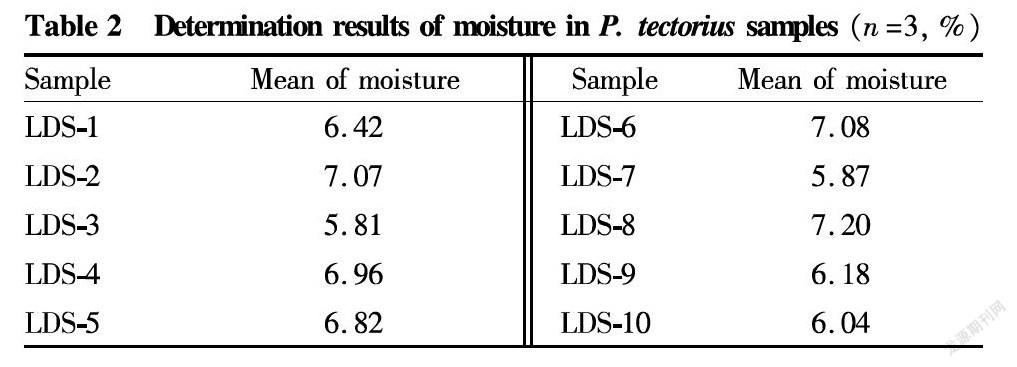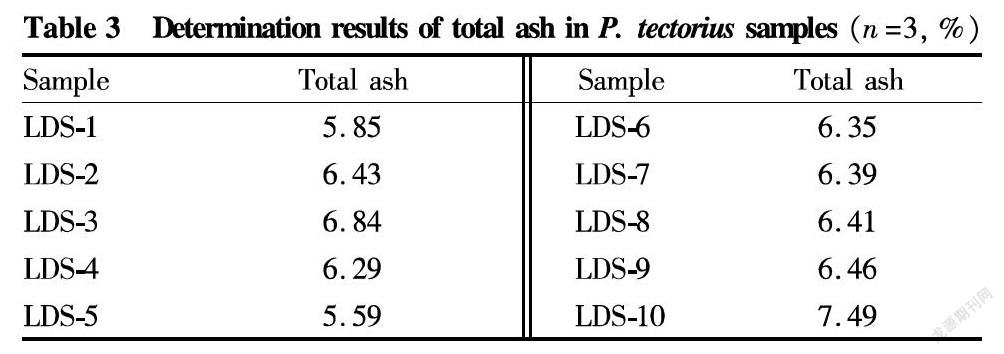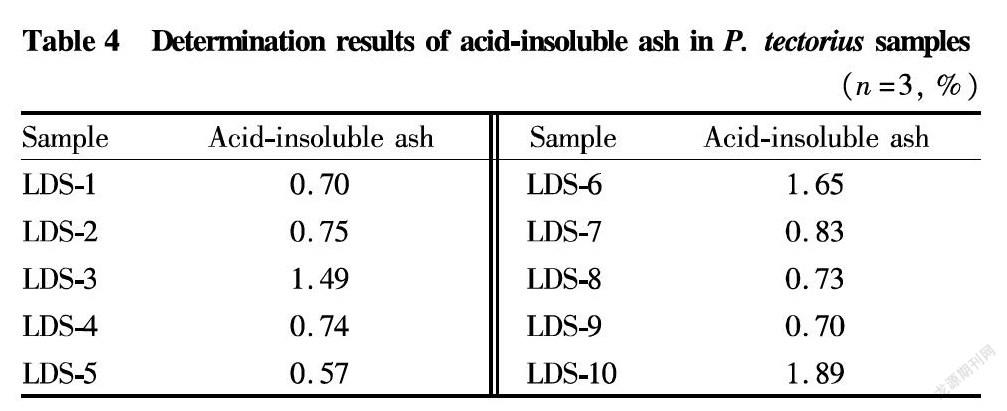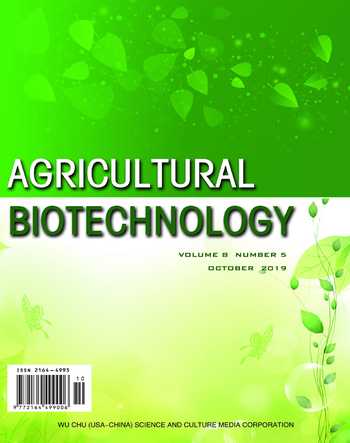Study on Quality Evaluation and Standards of the Zhuang Medicine Pandanus tectorius Soland.
Chao ZENG Tongyong LUO Songji WEI Huagang LIU Wei WEI Haicheng WEN




Abstract [Objectives] This study was conducted to establish the quality control standards for Pandanus tectorius Soland.
[Methods] Microscopic identification and thin layer chromatography were used to identify and determine the moisture, total ash and extract contents.
[Results] The root transection is near round. The outmost side is velamen. There are nearly 10 columns of collenchyma tissue cells inside. In the cortex, there are a large number of fiber bundles scattered, and there are also large mucous cells scattered. The endodermis is distinct, and the cells are small and closely arranged. The pericycle is distinct and forms a ring. The pericycle fiber bundles are arranged in a radial shape by more than 40 bundles of phloem and xylem alternately. The leaf transection is V-shaped. The collenchyma lies under the epidermis. The spongy tissue has many calcium oxalate square crystal and needle crystals. The mucous cells contain calcium oxalate square crystal and needle crystals. The thin layer identification indicated that in the chromatogram of each test sample, spots of the same colors appeared at the positions corresponding to the chromatogram of the reference medicinal material, and the reproducibility was good. The moisture contents of the 10 batches of samples were all below 8.0%. The total ash was below 8.0%. The acid-insoluble ash was below 2.0%. With 50% ethanol as the solvent, the extract contents were all over 12.5%.
[Conclusions] The microscopic identification results are reliable and can be used as the identification basis of P. tectorius. The thin layer identification method and the test results can provide a basis for quality control of P. tectorius.
Key words Pandanus tectorius Soland.; Quality standard; Thin layer chromatography; Identification
Pandanus tectorius Soland. is a plant in Pandanaceae, also called as Jiaboluo, Yeboluo and Loudoule. It roots and leaves can be used as a kind of traditional Chinese medicine. Its medicinal use can be found in He Kejians Shengcao Yaoxing Beiyao (Essentials for the Properties of Raw Herbs) in the Qing Dynasty, and Xiao Budans Lingnan Caiyao Lu (Records of Collecting Herbs in the South of the Five Ridges), as well as in the monographs of following feudal dynasties. The related medicinal value, original plant and geographical distribution of P. tectorius are also described in books such as Quanguo Zhongcaoyao Huibian (Collection of Traditional Chinese Medicine in China), Zhongyao Dacidian (Dictionary of Traditional Chinese Medicine), Chinese Materia Medica, etc.[1-3]. As a kind of folk herbal medicine, P. tectorius has a long history in the South of the Five Ridges. It is recorded as a commonly used medicine in the Standards for Traditional Chinese Medicine of Guangdong Province (2011 edition)[4]. P. tectorius is mainly distributed in Fujian, Taiwan, Guangdong, Hainan, Guangxi, Guizhou and Yunnan. In Guangxi, it is mainly distributed in Longzhou, Nanning, Rong County, Guiping, Hepu, Beihai, Fangcheng and Qinzhou. This herb grows along villages, roads, mountains, forest edges and seashore and in forests. In this study, in order to better develop and utilize the plant resources, P. tectorius was identified by microscope observation and thin layer chromatography, and the contents of moisture, total ash, acid-insoluble ash and extract were determined, laying a foundation for the development of the quality control standards of P. tectorius and the development of new medicines.
Materials and Methods
Experiment materials
Medicinal herb and reagents
The P. tectorius medicinal materials were collected from Nanning Gaofeng Forest Farm (LDS-1), Xingdaohu Township of Hepu County (LDS-2), Shiwan Town of Hepu County (LDS-3), Jiangshan Township of Fangcheng District (LDS-4), Sitang Town of Nanning City (LDS-5), Changle Town of Hepu County (LDS-6), Dalu Town of Fangcheng District (LDS-7), Maoling township of Fangcheng District (LDS-8), Huashi Town of Fangcheng District (LDS) -9) and Zhakou Town of Hepu County (LDS-10), which were identified as the roots and leaves of P. tectorius Soland. In this experiment, LDS-6 (Changle Town of Hepu County) was used as a control material which was compared with other samples. Reagents including chloroform, ethyl acetate and n-butanol were all analytical pure.
Instruments
Sartorius BS214D electronic analytical balance (Sartorius Scientific Instruments(Beijing) Co., Ltd.); DF-20 desktop continuous feeding mill (Wenling Linda Machinery Co., Ltd.); HH-4 digital thermostat water bath (Guohua Electric Appliance Co., Ltd.); 101A-3E electrothermal blowing dry box (Shanghai Testing Instrument Co., Ltd.); SX2 chamber electric furnace (Shanghai Testing Instrument Co., Ltd.); SK2200LHC ultrasonic cleaning instrument (Shanghai Kudos Ultrasonic Instrument Co., Ltd.); DM-2500M biological microscope (Leica Instrument Co., Ltd.).
Experiment methods
The parts of the fresh P. tectorius materials with a diameter of 3-10 mm were taken and prepared into permanent slides by paraffin sectioning and double staining. The root and the leaf samples were also dried, pulverized and sieved with a 60 mesh sieve, and prepared into slides with dilute glycerin. The slides were observed and imaged with a DM2500M biological microscope.
Results and Analysis
Observation of P. tectorius slices
Root transection
The root transection is near round. The outmost side is velamen with obviously thickened outwall. There are nearly 10 columns of collenchyma tissue cells inside. The cortex is broad, occupying most of the transection; there are a large number of fiber bundles scattered, and the cell wall is not lignified; and there are large mucous cells scattered, elliptical or irregular oblong with a diameter of 250 μm and a length up to 500 μm. The endodermis is distinct, and the cells are small and closely arranged. The pericycle is distinct and forms a ring. The pericycle fiber bundles are arranged in a radial shape by more than 40 bundles of phloem and xylem alternately; the phloem is narrow, and has only a few rows of cells and 1 to 2 columns of wood fibers on the outside; and the center is a broad xylem in which a large number of large quasi-circular vessels are scattered, as shown in Fig. 1.
Leaf transection
The leaf transection is V-shaped. There is one column of oval upper and lower epidermis cells. The collenchyma lies under the epidermis. There is one column of cylindrical palisade cells. The spongy tissue is composed of round or elliptical parenchymal cells, which are loose and different in size, mostly located near the lower epidermis; and the spongy tissue has many calcium oxalate square crystal and needle crystals. The mucous cells contain calcium oxalate square crystal and needle crystals. Among the midrib vascular bundles, there are fewer and large vessels. And the collenchyma lies under the vascular bundles, as shown in Fig. 2.
Power characteristics
The powder is yellowish brown. The starch grains are quasi-circular, each having a diameter of 8-18 μm. The compound starch grains are composed of 2 to 4 single starch grains. There are many calcium oxalate needle crystals, forming bundles or scattered, and the intact ones have a length up to 250 μm. Calcium oxalate square crystals also could be observed, nearly square, with a diameter of 13-35 μm. Calcium oxalate cluster crystals can be observed rarely, with a diameter of 30-40 μm. The fibers are bundled, extremely long; and the cell wall is thick, and the cell cavity is linear. Crystal sheath fibers can be observed commonly. The vessels are threaded, scalariform and bordered pit vessels, with a diameter of 25 to 142 μm. The stomata are of the paracytic type. Oval-like secretions are scattered commonly. And brown bodies are also common, as shown in Fig. 3.
Extract determination
With water, 30% ethanol, 50% ethanol, 70% ethanol and 95% ethanol as the extraction and extracting solvents, the extracts were obtained by cold extracting method and hot extracting method and then determined according to "extract determination method" in Chinese Pharmacopeoia (2015 edition). The results of various extraction methods were compared and analyzed. The determination results showed that the extracting amount of the hot extracting method was higher than that of the cold extracting method. The hot extracting amount of 50% ethanol was significantly higher than those of other concentrations of ethanol (using the sample LDS-4). Specifically, the hot extracting content with 50% ethanol was 14.916%, and those with water, 30% ethanol, 70% ethanol and 95% ethanol were 14.254%, 13.716%, 13.017% and 7.699%, respectively. Therefore, 50% ethanol was finally determined as the solvent. According to the hot extracting method under the alcohol-soluble extract determination method, 10 batches of extracts were determined, and the results are shown in Table 1.
It can be seen from the above results that the extract contents of the 10 batches of samples were all over 12.5%. Therefore, according to the above-mentioned 10 batches of measurement data, the extract content of the product was formulated to be not less than 12.5%.
Moisture determination
Moisture was determined according to "the first method for determination of moisture" in Chinese Pharmacopeoia (2015 edition). The results are shown in Table 2.
It can be seen from the above results that the moisture contents of the 10 batches of samples were below 8.0%. Because the medicinal materials are produced in the south and the southern climate is relatively humid, the moisture content of this product should not be more than 10.0%.
Total ash determination
The total ash contents were determined according to "ash determination method" in Chinese Pharmacopeoia (2015 edition). The results are shown in Table 3.
It can be seen from the above results that the total ash contents of the 10 batches of samples were lower than 8.0%. Therefore, according to the above 10 batches of measurement data, the total ash content of the product should not exceed 8.0%.
Acid-insoluble ash
Acid-insoluble ash was determined according to "ash determination method" in Chinese Pharmacopeoia (2015 edition). The results are shown in Table 4.
Agricultural Biotechnology2019
It can be seen from the above results that the acid-insoluble ash contents of the 10 batches of samples were less than 2.0%. Therefore, according to the above-mentioned 10 batches of measurement data, the acid-insoluble ash of the product was formulated to be no more than 2.0%.
Thin-layer chromatography identification
Because no specific index components were found in P. tectorius, so the reference medicinal material was used as a control. A certain amount of each product (5 g) was added with 100 ml of 95% ethanol, ultrasonically treated for 40 min and filtered, obtaining the filtrate, which was concentrated to near dryness and then dissolved with 2 ml of 90% ethanol, giving a test solution. The reference medicinal material was also taken and prepared according to this method to a reference solution. Testing was then carried out according to 0502 thin-layer chromatography under "chromatography" in Chinese Pharmacopeoia (2015 edition). Specifically, 10 μl was taken from the above two solutions and applied on the same silica gel G thin layer plate, respectively. Development was performed with petroleum ether-ethyl acetate-glacial acetic acid (9∶4∶0.1) as a developing solvent, followed by taking out and air drying. The silica gel G thin layer plate was observed under an ultraviolet lamp (365 nm). The 10 batches of samples were tested according to this method and all met the requirements. In the chromatogram of each test sample, the same fluorescent spots were displayed at the positions corresponding to the chromatogram of the reference medicinal material.
Durability test: ① The developing effects of the self-made plate and prefabricated plate (provided by Qingdao Haiyang Chemical Co., Ltd., lot number: 20140108) were investigated. ② Different developing temperatures (5 and 29 ℃) were investigated. ③ The dot-like and strip-like sample applying methods were investigated. The results of the investigations showed that the durability of the method was good.
Different developing systems were compared, including petroleum ether : acetone (6∶4), chloroform : ethyl acetate: ethanol (2∶4∶4), chloroform : ethyl acetate: n-butanol (1∶1∶1) and petroleum ether : cyclohexane (6∶4). Finally, petroleum ether∶ethyl acetate∶glacial acetic acid (9∶4∶0.1) was selected as the developing agent as it showed a better development effect with separated and clear spots. Therefore, the system was selected as the developing agent for thin layer identification. Among a variety of inspection methods, observing under a UV lamp (365nm) was determined as the inspection method.
From the thin layer identification chromatograms of the 10 batches of P. tectorius, it can be seen that for each batch of P. tectorius, spots were observed at the same positions as the reference medicinal material, as shown in Fig. 4.
Conclusion and Discussions
Microscopic results
The root transection is near round. The outmost side is velamen. There are nearly 10 columns of collenchyma tissue cells inside. In the cortex, there are a large number of fiber bundles scattered, and there are also large mucous cells scattered. The endodermis is distinct, and the cells are small and closely arranged. The pericycle is distinct and forms a ring. The pericycle fiber bundles are arranged in a radial shape by more than 40 bundles of phloem and xylem alternately. The leaf transection is V-shaped. The collenchyma lies under the epidermis. The spongy tissue has many calcium oxalate square crystals and needle crystals. The mucous cells contain calcium oxalate square crystals and needle crystals. The above characteristics can be used as the basis for the identification of P. tectorius.
Determination items
The results showed that the results of the moisture content, total ash content, acid-insoluble ash content and water-soluble extract and alcohol-soluble extract contents of the P. tectorius medicinal materials were in accordance with related requirements for the first method for determination of moisture (drying method), ash determination method and extraction determination method in Chinese Pharmacopeoia (2015 edition). The moisture contents of the 10 batches of samples were all below 8.0%. The total ash was below 8.0%. The acid-insoluble ash was below 2.0%. With 50% ethanol as the solvent, the extract contents were all over 12.5%.
Thin-layer identification
The results of thin layer identification showed that in the chromatograms of P. tectorius, each batch of P. tectorius showed spots of the same colors at the same positions in the chromatogram of reference material HGT-11.
The study laid a foundation for the development of quality control standards for P. tectorius and the development of new drugs.
Chromatographic conditions: Silica gel G thin layer plate (Qingdao Haiyang Chemical Co., Ltd., lot number: 20140108, specification: 10 cm×20 cm); dot-like sample application, sample application amount: 10 μl; temperature: 29 ℃; relative humidty: 65RH%; the developing agent: petroleum ether : ethyl acetate : glacial acetic acid (9∶4∶0.1).
Fig. 4 Chromatograms of P. tectorius samples
References
[1]Editorial Group of Collection of Traditional Chinese Medicine in China. Collection of traditional Chinese medicine in China[M]. Beijing: Peoples Medical Publishing House, 1996: 973. (in Chinese)
[2]Nanjing University of Traditional Chinese Medicine. Dictionary of traditional Chinese medicine[M]. Shanghai: Shanghai Scientific and Technical Publishers, 1975: 3863-3864. (in Chinese)
[3]Editorial Board of Chinese Materia Medica, State Administration of Traditional Chinese Medicine. Chinese materia medica[M]. Shanghai: Shanghai Scientific and Technical Publishers, 1999. 536. (in Chinese)
[4]Guangdong Food and Drug Administration. Guangdong Traditional Chinese Medicine Standards[M]. Guangzhou: Guangdong Science and Technology Press, 2011. (in Chinese)
[5]Editorial Board of Flora of China, Chinese Academy of Sciences. Flora of China[M]. Beijing: Science Press, 1992. (in Chinese)
[6]YAO RS, XUE YQ, WANG ZZ. Establishment of gas chromatographic analysis method for wash oil components in coal tar[J]. Chinese Journal of Analysis Laboratory, 2009, 28( 5) : 125-127. (in Chinese)
[7]YANG RP, DUAN RE. Extraction, application and prospect of the components of wash oil[J]. Chemical Processing of Coal, 2006, 35(5): 61-64. (in Chinese)
[8]WU BG, YANG YW, ZHANG WH, et al. Extraction and application of menaquinone in wash oil[J]. Heibei Chemical Industry, 1999(3): 3-5. (in Chinese)
[9]ZHAO XC. Measurement of β-methyl naphthalene content with gas chromatography[J]. Fuel & Chemical Processes, 2007 (3): 43-45. (in Chinese)
[10]FENG XQ, GU MG, WANG C, et al. Study on the chemical constituents of mangrove plant Pandanus tectorius soland[J]. Applied Chemical Industry, 2013(6): 1154-1155, 1158. (in Chinese)
[11]PENG LH, LIU JW, ZHENG JK, et al. Analysis of amino acids and inorganic elements in the roots of Pandanus tectorius Soland[J]. Chinese Journal of Ethnomedicine and Ethnopharmacy, 2012(5): 24-25. (in Chinese)
[12]LIU JW, PENG LH, XIAN MT, et al. Supercritical carbon dioxide extraction of volatile oil from Pandanus tectorius Soland and analysis by GC-MS[J]. Modern Chinese Medicine, 2012, 04: 4-6. (in Chinese)
[13]Guangdong Institute of Traditional Chinese Medicine. Lingnan herbal[M]. Shanghai: Shanghai Scientific and Technical Publishers, 1960: 1351. (in Chinese)
[14]South China Institute of Botany, Chinese Academy of Sciences. Guangdong flora[M]. Guangzhou: Guangdong Science and Technology Press, 1995: 400-4021. (in Chinese)
[15]PEUNGVICHA PENCHOM, THIRAWARAPAN SUWAN S, WATANABE HIROSHI. Possible mechanism of hypoglycemic effect of 4-hydroxybenzo icacid, aconstituents of Pandanus odorus root[J]. Japanese Journal of Pharmacology, 1998, 78(3): 395-398.
[16]UDDIN SJ, SHILPI JA, RALMAN MT, et al. Assessment of neurophamacogical activities of Pandanus foetidus (Pandanaceae) inmice[J]. Phamazie, 2006, 61(4): 362-364.
- 农业生物技术(英文版)的其它文章
- Analysis of the Southern China Tilapia Production and Economic Benefits of Different Breeding Patterns in 2018
- Dynamic Monitoring and Control Measures of Spodoptera frugiperda (J.E.Smmith) in Low Latitude Plateau Sugarcane Areas
- Control Effects of a New Sex Pheromone Trap and Biological Agents on Sesamia inferens Walker and Argyroploce schistaceana (Snellen)
- Comparative Study on Grain Cadmium Content and Yield in Different Rice Varieties
- Simulation Experiment of Air Temperature Variation in Multi-film Covering at Night
- Identification of Growth-promoting Bacteria from Rhizosphere of Pastures and Their Effects on Growth of Lotus corniculatus L.

